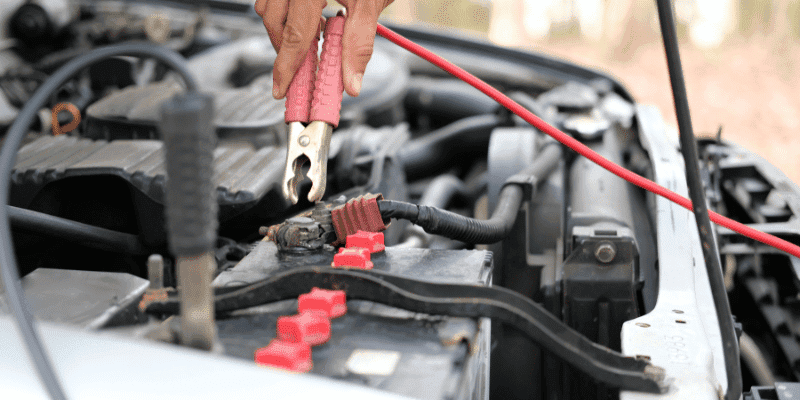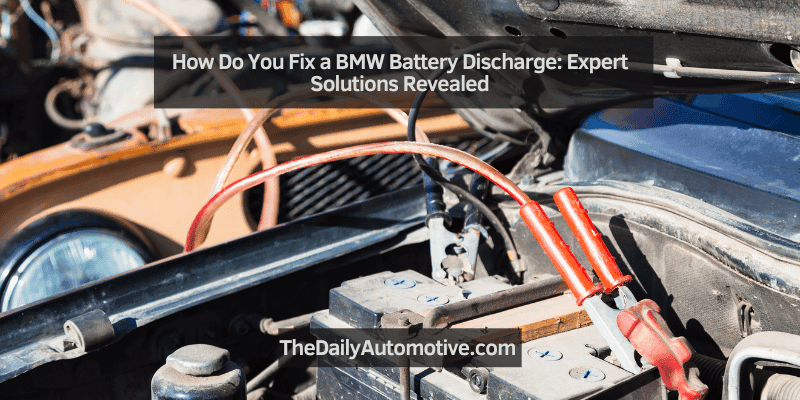How Do You Fix a BMW Battery Discharge: Expert Solutions Revealed
To fix a BMW battery discharge, you need to charge or replace the battery. Owning a BMW comes with its perks, but like any other car, sometimes problems arise.
One common issue is a battery discharge, which can leave you stranded and unable to start your vehicle. Fortunately, resolving this problem is relatively straightforward. By either charging the battery using a battery charger or replacing it entirely, you can ensure your BMW starts up reliably.
We will delve into the steps you can take to fix a BMW battery discharge. Whether you are a BMW owner or a mechanic looking to troubleshoot this problem for a customer, the information provided will guide you through the process.
Understanding The Causes Of Bmw Battery Discharge
Understanding the causes of BMW battery discharge is essential for effective troubleshooting. By identifying common culprits like faulty alternators, parasitic drains, or battery age, you can take the necessary steps to fix the issue and prevent future problems.
Car trouble is never convenient, especially when it comes to a BMW battery discharge issue. A dead battery can leave you stranded and frustrated. To prevent this inconvenience, it’s essential to understand the causes of BMW battery discharge. By diagnosing the root cause, you can take the necessary steps to fix the problem and avoid future battery drain.
Symptoms Of Battery Discharge
When your BMW experiences battery discharge, it may exhibit various symptoms. Being aware of these signs can help you identify the issue before it worsens. Here are some common symptoms to watch out for:
- Slow cranking: If your BMW takes longer than usual to start or cranks slowly, it may indicate a battery discharge problem.
- Dim lights: Flickering or dim headlights, interior lights, or dashboard lights can be a sign of battery drain.
- Electrical issues: Unresponsive power windows, malfunctioning electronics, or a weak sound system can be attributed to a failing battery.
- Warning lights: If you notice warning lights on your dashboard, such as the battery or check engine light, it may point to a battery discharge issue.
Importance Of Diagnosing The Root Cause
Diagnosing the root cause of a BMW battery discharge is crucial for two primary reasons:
- Preventative maintenance: Identifying the underlying cause of battery drain allows you to address the issue promptly, preventing further damage and potential breakdowns.
- Cost-effective solution: By diagnosing the root cause correctly, you can avoid unnecessary repairs or part replacements, saving both time and money.
Common Reasons Behind Battery Discharge
Several factors can contribute to BMW battery discharge. Understanding these common reasons will help you pinpoint the cause more effectively. Here are some potential culprits:
- Parasitic draw: When an electrical component continues to draw power even when the vehicle is turned off, it can result in battery discharge. Common culprits include malfunctioning interior lights, faulty alarm systems, or improperly installed accessories.
- Battery age and condition: Over time, a battery’s capacity diminishes, leading to a reduced ability to hold a charge. Extreme temperatures, insufficient maintenance, or prolonged inactivity can further accelerate battery aging.
- Alternator malfunction: The alternator is responsible for recharging the battery while the engine is running. If the alternator fails, it may not generate enough power, resulting in battery drain.
- Faulty electrical connections: Loose, corroded, or damaged battery connections can disrupt the charging process, leading to battery discharge.
- Inadequate driving: Extended periods of short trips or long-term vehicle storage without regular use can prevent the battery from fully recharging, leading to discharge.
Understanding the symptoms and common causes of BMW battery discharge is the first step in diagnosing the issue. By taking appropriate measures, such as addressing the root cause and ensuring proper battery maintenance, you can avoid unexpected breakdowns and keep your BMW running smoothly.
Diy Steps To Fix A Bmw Battery Discharge
Fixing a BMW battery discharge can be done with these DIY steps. Start by checking the battery connections and then try jumpstarting the car. If the issue persists, it may be necessary to replace the battery. Remember to consult with a professional if needed.
Step 1: Checking For Any Electrical Accessories Draining The Battery
- Start by turning off the engine and all electrical components, such as lights, radio, and air conditioning.
- Inspect the interior and exterior lights to ensure they are not accidentally left on.
- Check for any aftermarket accessories, like phone chargers or dashcams, that may be draining the battery when the vehicle is not in use.
- If you suspect a drain, use a multimeter to identify the specific accessory that is causing the problem. Disconnect it and see if the battery discharge issue resolves.
Step 2: Inspecting And Testing The Battery
- Begin by visually inspecting the battery for any signs of damage, such as leaks or corrosion. If any issues are found, the battery may need to be replaced.
- Use a voltmeter to measure the battery’s voltage. A fully charged battery should read around 12.6 volts. Anything below 12 volts may indicate a discharged or weak battery.
- Test the battery’s cold cranking amps (CCA) using a battery tester. Ensure that the CCA value meets or exceeds the manufacturer’s specifications. If it falls short, a new battery may be required.
Step 3: Verifying Battery Connections And Terminals
- Check the battery cables for any signs of looseness or corrosion. Tighten any loose connections and clean off any corrosion with a wire brush or battery terminal cleaner.
- Inspect the battery terminals to ensure they are making good contact with the cables. If there is any corrosion present, clean it off using a mixture of baking soda and water or a specialized terminal cleaner.
- Apply a small amount of dielectric grease or petroleum jelly to the battery terminals after cleaning to prevent future corrosion.
Step 4: Assessing The Alternator And Charging System
- Start the vehicle and use a multimeter to measure the voltage at the battery terminals while the engine is running. The voltage should read around 13.8 to 14.8 volts. Anything significantly lower or higher may indicate an issue with the alternator or charging system.
- Inspect the alternator belt for any signs of wear or damage. Replace if necessary.
- Check the connections between the alternator and battery, ensuring they are secure and free from corrosion. Clean as needed.
Step 5: Identifying And Addressing Any Electrical System Faults
- Consult the vehicle’s wiring diagram and use a voltage meter to test for any abnormal voltage drops across various electrical circuits. This can help identify faulty components or wiring harnesses.
- Inspect fuse boxes for any blown fuses and replace them with the appropriate rating.
- If necessary, use an automotive diagnostic tool to scan for any stored fault codes in the vehicle’s computer system. Address any identified issues accordingly.
Step 6: Recharging Or Replacing The Battery If Necessary
- If the battery can still hold a charge, use a battery charger to recharge it fully. Follow the charger manufacturer’s instructions for safe and effective charging.
- If the battery fails to hold a charge or falls below the recommended voltage during testing, it may need to be replaced. Consult a reputable automotive parts store or contact a professional mechanic for assistance in selecting the correct battery for your BMW.
By following these DIY steps, you can troubleshoot and fix a BMW battery discharge issue. However, if you’re not confident in your abilities or the problem persists after attempting these steps, it’s recommended to seek the help of a qualified mechanic or BMW dealership.
Expert Tips For Preventing Bmw Battery Discharge
Prevent BMW battery discharge with these expert tips: perform regular maintenance checks, avoid leaving lights on, drive your vehicle often, store it properly with a battery maintainer, and consider a battery upgrade if needed.
It’s frustrating when you hop into your BMW, ready to hit the road, only to find that the battery is dead. To avoid such a disappointment, here are some expert tips to help you prevent BMW battery discharge.
Regular Maintenance And Inspection Routines
Regular maintenance and inspections play a vital role in preserving your BMW’s battery life. Here are some key practices to implement:
- Schedule regular maintenance appointments with a certified BMW technician to ensure the battery is in optimal condition.
- Inspect the battery terminals for any signs of corrosion and clean them if necessary.
- Check the battery voltage regularly using a multimeter to ensure it’s within the recommended range.
- Ensure that the battery is securely fastened in place and there are no loose connections.
Avoiding Common Mistakes That Lead To Battery Drain
Certain common mistakes can unknowingly drain your BMW’s battery. By being aware of these pitfalls, you can prevent unnecessary battery discharge. Consider the following:
- Avoid leaving lights, radio, or other accessories on when the engine is off.
- Double-check that all doors, windows, and the trunk are fully closed to prevent lights from being left on.
- Be cautious when using power-hungry features like heated seats or USB chargers, as they can drain the battery faster.
- Minimize short trips, as it can prevent the battery from fully charging.
Tips For Preserving Battery Life
Follow these tips to extend the lifespan of your BMW’s battery:
- Whenever possible, park your car in a shaded area to protect the battery from extreme temperatures.
- Disconnect any aftermarket devices, such as dashcams or phone chargers, when not in use to reduce unnecessary battery drain.
- If your BMW will not be used for an extended period, consider using a trickle charger to maintain the battery’s charge.
- Start your car at least once a week and let it idle for a few minutes to ensure the battery remains charged.
Ensuring Proper Storage During Extended Periods Of Inactivity
When faced with extended periods of inactivity, it’s important to store your BMW correctly to prevent battery discharge. Consider the following steps:
- Clean your BMW thoroughly and apply a protective wax coat to help preserve its exterior during storage.
- Fill up the fuel tank to prevent condensation and add a fuel stabilizer to prevent fuel degradation.
- Disconnect the negative terminal of the battery or use a battery maintainer to ensure it retains its charge.
- Store your BMW in a cool, dry place away from direct sunlight to prevent unnecessary battery drain.
By incorporating these expert tips into your routine, you can avoid the frustration of a BMW battery discharge and ensure that your car is always ready for the road ahead.

Frequently Asked Questions On How Do You Fix A Bmw Battery Discharge
Why Does My Bmw Says Battery Discharged?
Your BMW is indicating “battery discharged” because the battery is low on power.
How Do I Fix My Battery Discharge Warning?
To fix a battery discharge warning, try these steps:
1. Check for any background apps or processes that may be draining your battery.
2. Adjust your device settings to optimize battery usage.
3. Disable unnecessary features like location services, push notifications, and automatic app updates.
4. If the issue persists, consider replacing your battery or seeking professional assistance.
How Do You Reset A Bmw Battery?
To reset a BMW battery, follow these steps: disconnect the negative terminal, wait 15 minutes, reconnect the terminal.
What Does It Mean When My Car Says Battery Discharged?
When your car says “battery discharged”, it means that the battery is low on charge and needs to be recharged.
Conclusion
To wrap up, fixing a BMW battery discharge issue doesn’t have to be daunting. By following the steps mentioned above, such as checking for electrical drains, inspecting the battery connections, and ensuring proper charging, you can effectively troubleshoot and resolve the problem.
Regularly maintaining your vehicle’s battery and practicing good driving habits can also help prevent battery issues in the future. Remember to check for any software updates and keep your BMW’s electrical system in top condition. If you’re ever unsure or facing persistent battery discharge problems, don’t hesitate to consult a professional mechanic.
Taking these steps will not only resolve the battery discharge issue, but also enhance the performance and lifespan of your BMW, ensuring a smooth and trouble-free driving experience.







